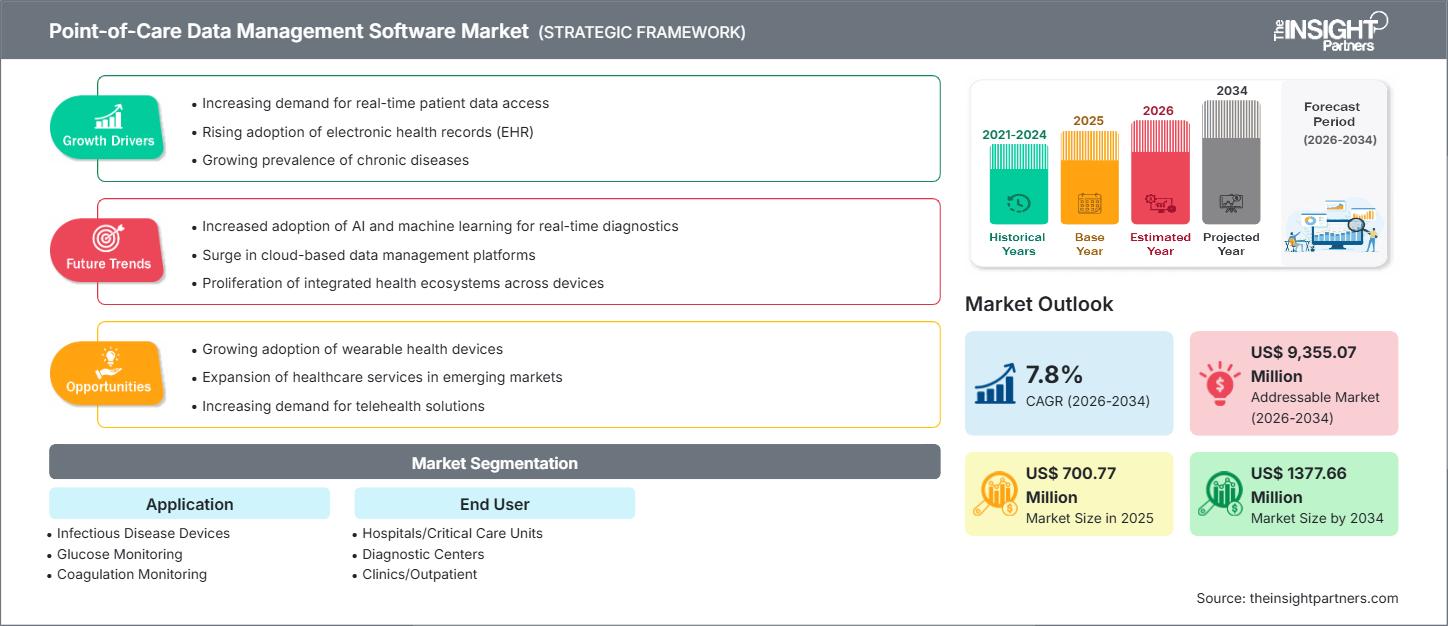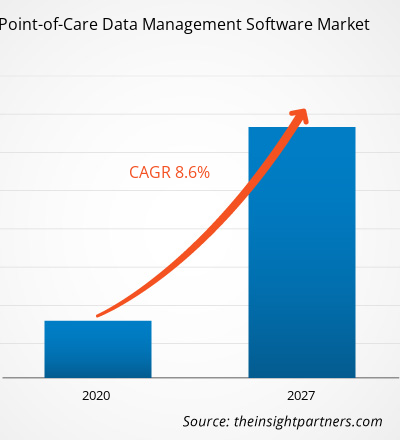Der Markt für Point-of-Care (POC)-Datenmanagementsoftware wird voraussichtlich von 700,77 Millionen US-Dollar im Jahr 2025 auf 1377,66 Millionen US-Dollar im Jahr 2034 wachsen, was einer durchschnittlichen jährlichen Wachstumsrate (CAGR) von 7,8 % im Prognosezeitraum (2020–2027) entspricht.
Marktanalyse für Point-of-Care-Datenmanagementsoftware
Der Markt für Point-of-Care-Datenmanagement-Software steht vor einem starken Wachstum, angetrieben durch die zunehmende Nutzung von Point-of-Care-Tests (POCT) in klinischen Arbeitsabläufen, rasante technologische Fortschritte und den Bedarf an Echtzeit-Datenintegration. Gesundheitsdienstleister setzen vermehrt auf POC-Geräte (z. B. Blutzuckermessgeräte, Gerinnungsmonitore) und benötigen leistungsstarke Software, um Daten von diesen Geräten zu erfassen, zu analysieren und direkt an elektronische Patientenakten (EHR) oder Laborinformationssysteme (LIS) zu übertragen.
Darüber hinaus treibt der Anstieg der Telemedizin und der Fernüberwachung von Patienten die Nachfrage nach POC-Datenmanagementlösungen an, da diese eine nahtlose Datenerfassung aus verteilten Versorgungseinrichtungen ermöglichen und wertorientierte Versorgungsmodelle unterstützen.
Fortschritte in den Bereichen Cloud Computing, Datenanalyse und Middleware ermöglichen anspruchsvollere, interoperable und skalierbare POC-Datenmanagementplattformen – und machen diese damit für Krankenhäuser und Diagnosezentren attraktiver.
Marktübersicht für Point-of-Care-Datenmanagementsoftware
Point-of-Care-Datenmanagement-Software (POC-DMS) bezeichnet digitale Systeme, die Patientendaten von Point-of-Care-Geräten integrieren, speichern, verwalten und analysieren. Diese Systeme ermöglichen den Echtzeit-Datenaustausch zwischen Diagnosegeräten und zentralen Systemen (z. B. elektronischen Patientenakten) und verbessern so die klinische Entscheidungsfindung, reduzieren Fehler und optimieren Arbeitsabläufe. Durch die automatisierte Datenerfassung und -vernetzung unterstützt POC-DMS Gesundheitsdienstleister dabei, manuelle Eingriffe zu reduzieren, die Datengenauigkeit zu erhöhen und zeitnahe Interventionen zu ermöglichen.
Passen Sie diesen Bericht Ihren Anforderungen an.
Sie erhalten eine kostenlose Anpassung aller Berichte – einschließlich Teilen dieses Berichts, Länderanalysen und Excel-Datenpaketen – sowie attraktive Angebote und Rabatte für Start-ups und Universitäten.
Markt für Point-of-Care-Datenmanagementsoftware: Strategische Einblicke

-
Ermitteln Sie die wichtigsten Markttrends dieses Berichts.Diese KOSTENLOSE Probe beinhaltet eine Datenanalyse, die von Markttrends bis hin zu Schätzungen und Prognosen reicht.
Markttreiber und Chancen für Point-of-Care-Datenmanagementsoftware
Markttreiber:
- Zunehmende Verbreitung von Point-of-Care-Tests: Der zunehmende Einsatz von Geräten für die schnelle Diagnostik (z. B. Glukosemessgeräte, Gerinnungsmessgeräte) erhöht den Bedarf an Datenmanagement direkt am Behandlungsort.
- Telemedizin & Fernüberwachung: Der Aufstieg der virtuellen Versorgung und der Fernüberwachung von Patienten treibt die Nachfrage nach Software an, die Gerätedaten in zentrale Systeme zur kontinuierlichen Überwachung integrieren kann.
- Technologische Innovation: Fortschritte bei der Cloud-Infrastruktur, der Middleware-Konnektivität, der API-basierten Integration (z. B. Geräte-zu-EHR) und der Analytik verbessern die Fähigkeiten der POC-Datenmanagement-Software.
- Regulatorische und Qualitätsanforderungen: Vorschriften und klinische Leitlinien fordern zunehmend die genaue Erfassung, Zeitstempelung und Prüfung von Point-of-Care-Testergebnissen und fördern so den Einsatz dieser Lösungen. (Anmerkung: Abgeleitet von allgemeinen Trends in der IT des Gesundheitswesens.)
Marktchancen:
- Integration mit EHR- und LIS-Systemen: Die tiefere Integration von POC DMS mit elektronischen Patientenakten und Laborinformationssystemen ermöglicht einen nahtlosen Datenfluss, reduziert den manuellen Abgleich und unterstützt Echtzeitanalysen.
- Cloudbasierte und skalierbare Lösungen: Der Einsatz von Cloud-Lösungen ermöglicht skalierbare und kostengünstige Lösungen für Krankenhäuser, Kliniken und Diagnoselabore, insbesondere in Regionen mit begrenzten Ressourcen.
- KI und Datenanalyse: Der Einsatz von KI/ML auf POC-Daten (z. B. Anomalieerkennung, prädiktive Analysen) kann bei der Früherkennung, der Risikostratifizierung von Patienten und der betrieblichen Effizienz helfen.
- Expansion in Schwellenländer: Schwellenländer mit wachsender Gesundheitsinfrastruktur und zunehmender Nutzung von Point-of-Care-Tests bieten ein starkes Potenzial für Anbieter von Point-of-Care-DMS.
Marktsegmentierungsanalyse für Point-of-Care-Datenmanagementsoftware
-
Auf Antrag:
- Medizinprodukte gegen Infektionskrankheiten
- Glukoseüberwachung
- Gerinnungsüberwachung
- Urinanalyse
- Kardiometabolische Überwachung
- Krebsmarker
- Hämatologie
-
Vom Endbenutzer:
- Krankenhäuser / Intensivstationen
- Diagnostische Zentren
- Kliniken / Ambulante Versorgung
-
Nach Geographie:
- Nordamerika
- Europa
- Asien-Pazifik
- Lateinamerika
- Naher Osten und Afrika
Markteinblicke in die Software für das Datenmanagement am Point of Care
Die regionalen Trends und Einflussfaktoren auf den Markt für Point-of-Care-Datenmanagement-Software im gesamten Prognosezeitraum wurden von den Analysten von The Insight Partners eingehend erläutert. Dieser Abschnitt behandelt außerdem die Marktsegmente und die geografische Verteilung des Point-of-Care-Datenmanagement-Softwaremarktes in Nordamerika, Europa, Asien-Pazifik, dem Nahen Osten und Afrika sowie Süd- und Mittelamerika.
Umfang des Marktberichts zu Point-of-Care-Datenmanagementsoftware
| Berichtattribute | Details |
|---|---|
| Marktgröße im Jahr 2025 | 700,77 Millionen US-Dollar |
| Marktgröße bis 2034 | 1377,66 Millionen US-Dollar |
| Globale durchschnittliche jährliche Wachstumsrate (2026 - 2034) | 7,8 % |
| Historische Daten | 2021-2024 |
| Prognosezeitraum | 2026–2034 |
| Abgedeckte Segmente |
Durch Bewerbung
|
| Abgedeckte Regionen und Länder |
Nordamerika
|
| Marktführer und wichtige Unternehmensprofile |
|
Marktdichte von Point-of-Care-Datenmanagementsoftware: Auswirkungen auf die Geschäftsdynamik verstehen
Der Markt für Point-of-Care-Datenmanagement-Software wächst rasant, angetrieben durch die steigende Nachfrage der Endnutzer. Gründe hierfür sind unter anderem sich wandelnde Verbraucherpräferenzen, technologische Fortschritte und ein wachsendes Bewusstsein für die Vorteile des Produkts. Mit steigender Nachfrage erweitern Unternehmen ihr Angebot, entwickeln innovative Lösungen, um den Kundenbedürfnissen gerecht zu werden, und nutzen neue Trends, was das Marktwachstum zusätzlich beflügelt.

- Überblick über die wichtigsten Akteure im Markt für Point-of-Care-Datenmanagement-Software
Marktanteilsanalyse für Point-of-Care-Datenmanagementsoftware nach Regionen
- Nordamerika hält derzeit einen dominanten Marktanteil, was auf eine fortschrittliche Gesundheitsinfrastruktur, den weitverbreiteten Einsatz von Point-of-Care-Tests und die hohe Akzeptanz von IT im Gesundheitswesen zurückzuführen ist.
- Europa verzeichnet ein stetiges Wachstum, unterstützt durch die Einführung interoperabler Gesundheitssysteme, starke regulatorische Rahmenbedingungen und die steigende Nachfrage nach Point-of-Care-Diagnostik.
- Der asiatisch-pazifische Raum birgt aufgrund des erweiterten Zugangs zur Gesundheitsversorgung, der Zunahme privater Diagnostiklabore und der wachsenden Nutzung von Telemedizin ein steigendes Potenzial.
- Lateinamerika, der Nahe Osten und Afrika entwickeln sich zu aufstrebenden Regionen für POC DMS, wobei sich Chancen aus zunehmenden Investitionen in die Diagnostik, der steigenden Belastung durch chronische Krankheiten und digitalen Gesundheitsinitiativen ergeben.
Marktdichte der Point-of-Care-Datenmanagement-Software: Auswirkungen auf die Geschäftsdynamik verstehen
Wettbewerbsdruck und Differenzierung:
- Die Anbieter differenzieren sich durch Gerätekonnektivität (Integration mit einer breiten Palette von POC-Geräten), Middleware-Plattformen, Cloud-fähige Architekturen und Echtzeit-Analysen.
- Strategische Partnerschaften mit Herstellern von Diagnosegeräten und Anbietern von EHR/LIS sind üblich, um eine enge Integration und Dateninteroperabilität zu gewährleisten.
- Einige Anbieter legen Wert auf die Einhaltung gesetzlicher Vorschriften und stellen sicher, dass ihre Software klinische Prüfprotokolle, Datensicherheit und Berichtspflichten unterstützt.
- Skalierbarkeit (Cloud) und Flexibilität bei der Bereitstellung (On-Premises) sind entscheidende Wettbewerbsvorteile, um sowohl große Krankenhausnetzwerke als auch kleinere Kliniken zu bedienen.
Chancen und strategische Schritte:
- Mit Herstellern von POC-Geräten Allianzen eingehen, um Konnektivitätslösungen nativ zu integrieren.
- Entwicklung KI-gestützter Analysetools, die auf POC-Daten zugeschnitten sind (z. B. prädiktive Warnmeldungen, Patientenrisikobewertung).
- Ausbau der Präsenz in Schwellenländern durch das Angebot von SaaS-basierten POC-Datenmanagementlösungen.
- Bereitstellung von Modulen, die den regulatorischen Anforderungen entsprechen und Funktionen wie Audit-Protokollierung, Qualitätskontrolle und Unterstützung bei der Einhaltung von Vorschriften für klinische Einrichtungen bieten.
Wichtige Unternehmen auf dem Markt für POC-Datenmanagement-Software:
- Abbott Laboratories
- Siemens Healthineers AG
- TELCOR Inc.
- Orchard Software Corporation
- Randox Laboratories Ltd.
- Datalink LLC
- Radiometer Medical ApS
- THERMO FISHER SCIENTIFIC INC.
- F. HOFFMANN-LA ROCHE LTD.
Weitere im Rahmen der Studie bewertete Akteure:
- Danaher Corporation
- Roche Holding AG
- Medical Information Technology, Inc.
- Radiometer Medical ApS
- HemoCue AB
- Esaote SpA
- Hedera Biomedics srl
- Becton, Dickinson & Company (BD)
- GE Healthcare
Marktneuigkeiten und aktuelle Entwicklungen im Bereich Point-of-Care-Datenmanagement-Software
- Die Bedeutung cloudbasierter POC-Datenverwaltung nimmt zu, da Gesundheitsdienstleister von lokalen Systemen auf skalierbare Fernzugriffsmodelle umsteigen.
- Regulatorische Anforderungen und Qualitätssicherungsmaßnahmen innerhalb klinischer Arbeitsabläufe drängen die Anbieter dazu, ihre Fähigkeiten zur Datenverwaltung (Audit-Trails, Zeitstempel) zu verbessern.
- Das Bestreben nach wertorientierter Versorgung ermutigt Leistungserbringer, POC-Datenmanagementplattformen einzuführen, die die Ergebnisüberwachung, die Kosteneffizienz und patientenzentrierte Arbeitsabläufe unterstützen.
Marktbericht über Point-of-Care-Datenmanagementsoftware: Abdeckung und Ergebnisse
Der Bericht „Marktprognose für Point-of-Care-Datenmanagementsoftware (2021–2034)“ bietet Folgendes:
- Marktgröße und Prognose (global, regional) für alle wichtigen Segmente (Lieferart, Anwendung, Endnutzer)
- Marktdynamik: Trends, Treiber, Hemmnisse und Chancen
- SWOT-Analyse und PEST-Analyse (politische, wirtschaftliche, soziale und technologische Faktoren, die den Markt beeinflussen)
- Wettbewerbsumfeld: Hauptakteure, Geschäftsstrategien, Marktkonzentration, regionale Heatmap
- Aktuelle Entwicklungen und Partnerschaften (z. B. mit Herstellern von Point-of-Care-Geräten)
- Unternehmensprofile führender und aufstrebender Anbieter im POC-DMS-Markt
- Historische Analyse (2 Jahre), Basisjahr, Prognose (7 Jahre) mit CAGR
- PEST- und SWOT-Analyse
- Marktgröße Wert/Volumen – Global, Regional, Land
- Branchen- und Wettbewerbslandschaft
- Excel-Datensatz
Aktuelle Berichte
Erfahrungsberichte
Grund zum Kauf
- Fundierte Entscheidungsfindung
- Marktdynamik verstehen
- Wettbewerbsanalyse
- Kundeneinblicke
- Marktprognosen
- Risikominimierung
- Strategische Planung
- Investitionsbegründung
- Identifizierung neuer Märkte
- Verbesserung von Marketingstrategien
- Steigerung der Betriebseffizienz
- Anpassung an regulatorische Trends






















 Kostenlose Probe anfordern für - Markt für Point-of-Care-Datenmanagementsoftware
Kostenlose Probe anfordern für - Markt für Point-of-Care-Datenmanagementsoftware